Organizational Management in Healthcare: Strategy Development Report
VerifiedAdded on 2023/06/07
|5
|1366
|358
Report
AI Summary
This report provides an analysis of organizational management within the healthcare sector, specifically focusing on Chandler Health. It outlines the process of establishing the needs of patients and the community, emphasizing the importance of profiling and planning public health programs. The report identifies key internal and external stakeholders, including local authorities, patients, and various healthcare professionals. It also explores strategies for engaging staff in the creation and communication of the organizational strategy, highlighting the significance of trust, transparency, and storytelling. Furthermore, the report details the evaluation process, including determining the appropriateness of objectives, plans, and results to measure the strategy's effectiveness. References from various authors are included to support the analysis.
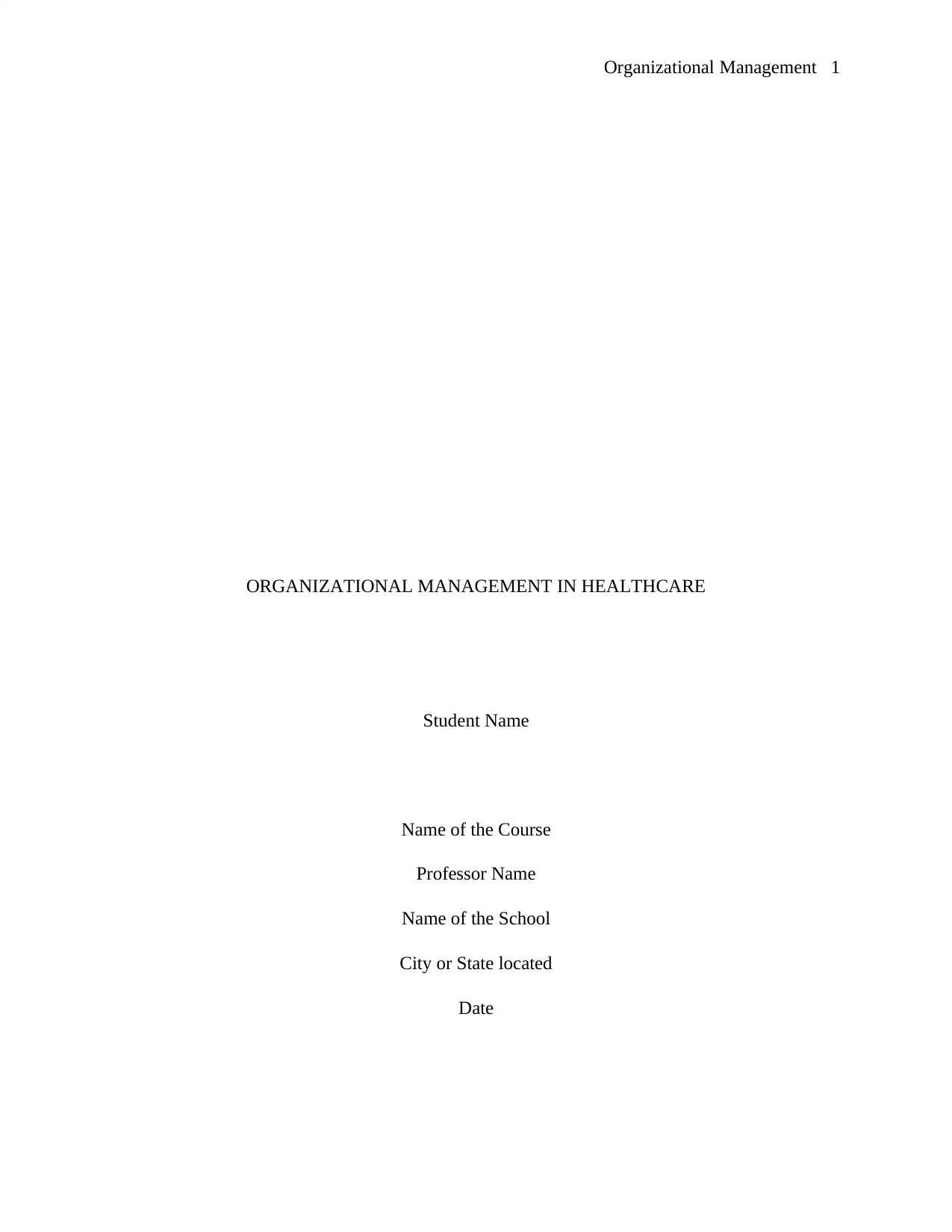
Organizational Management 1
ORGANIZATIONAL MANAGEMENT IN HEALTHCARE
Student Name
Name of the Course
Professor Name
Name of the School
City or State located
Date
ORGANIZATIONAL MANAGEMENT IN HEALTHCARE
Student Name
Name of the Course
Professor Name
Name of the School
City or State located
Date
Paraphrase This Document
Need a fresh take? Get an instant paraphrase of this document with our AI Paraphraser
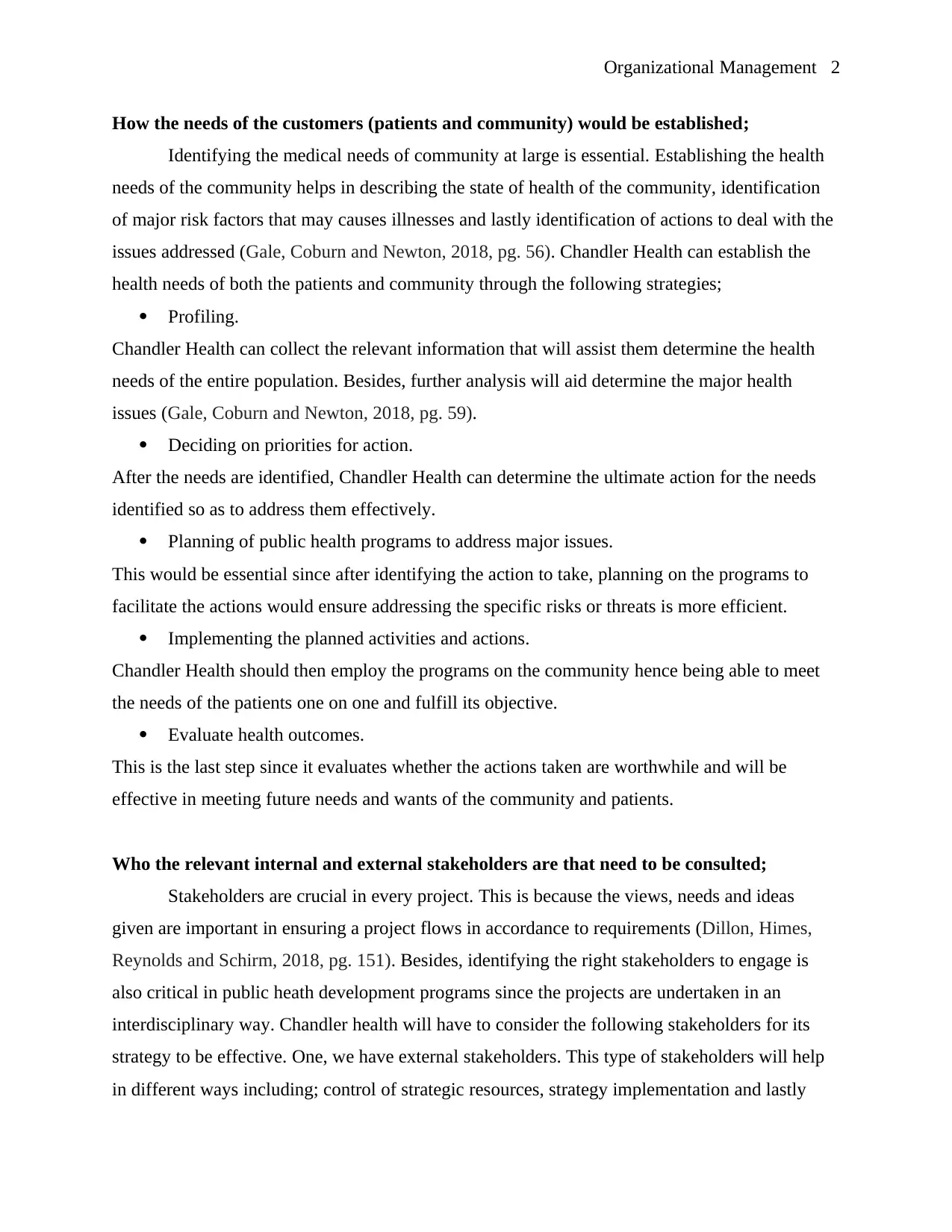
Organizational Management 2
How the needs of the customers (patients and community) would be established;
Identifying the medical needs of community at large is essential. Establishing the health
needs of the community helps in describing the state of health of the community, identification
of major risk factors that may causes illnesses and lastly identification of actions to deal with the
issues addressed (Gale, Coburn and Newton, 2018, pg. 56). Chandler Health can establish the
health needs of both the patients and community through the following strategies;
Profiling.
Chandler Health can collect the relevant information that will assist them determine the health
needs of the entire population. Besides, further analysis will aid determine the major health
issues (Gale, Coburn and Newton, 2018, pg. 59).
Deciding on priorities for action.
After the needs are identified, Chandler Health can determine the ultimate action for the needs
identified so as to address them effectively.
Planning of public health programs to address major issues.
This would be essential since after identifying the action to take, planning on the programs to
facilitate the actions would ensure addressing the specific risks or threats is more efficient.
Implementing the planned activities and actions.
Chandler Health should then employ the programs on the community hence being able to meet
the needs of the patients one on one and fulfill its objective.
Evaluate health outcomes.
This is the last step since it evaluates whether the actions taken are worthwhile and will be
effective in meeting future needs and wants of the community and patients.
Who the relevant internal and external stakeholders are that need to be consulted;
Stakeholders are crucial in every project. This is because the views, needs and ideas
given are important in ensuring a project flows in accordance to requirements (Dillon, Himes,
Reynolds and Schirm, 2018, pg. 151). Besides, identifying the right stakeholders to engage is
also critical in public heath development programs since the projects are undertaken in an
interdisciplinary way. Chandler health will have to consider the following stakeholders for its
strategy to be effective. One, we have external stakeholders. This type of stakeholders will help
in different ways including; control of strategic resources, strategy implementation and lastly
How the needs of the customers (patients and community) would be established;
Identifying the medical needs of community at large is essential. Establishing the health
needs of the community helps in describing the state of health of the community, identification
of major risk factors that may causes illnesses and lastly identification of actions to deal with the
issues addressed (Gale, Coburn and Newton, 2018, pg. 56). Chandler Health can establish the
health needs of both the patients and community through the following strategies;
Profiling.
Chandler Health can collect the relevant information that will assist them determine the health
needs of the entire population. Besides, further analysis will aid determine the major health
issues (Gale, Coburn and Newton, 2018, pg. 59).
Deciding on priorities for action.
After the needs are identified, Chandler Health can determine the ultimate action for the needs
identified so as to address them effectively.
Planning of public health programs to address major issues.
This would be essential since after identifying the action to take, planning on the programs to
facilitate the actions would ensure addressing the specific risks or threats is more efficient.
Implementing the planned activities and actions.
Chandler Health should then employ the programs on the community hence being able to meet
the needs of the patients one on one and fulfill its objective.
Evaluate health outcomes.
This is the last step since it evaluates whether the actions taken are worthwhile and will be
effective in meeting future needs and wants of the community and patients.
Who the relevant internal and external stakeholders are that need to be consulted;
Stakeholders are crucial in every project. This is because the views, needs and ideas
given are important in ensuring a project flows in accordance to requirements (Dillon, Himes,
Reynolds and Schirm, 2018, pg. 151). Besides, identifying the right stakeholders to engage is
also critical in public heath development programs since the projects are undertaken in an
interdisciplinary way. Chandler health will have to consider the following stakeholders for its
strategy to be effective. One, we have external stakeholders. This type of stakeholders will help
in different ways including; control of strategic resources, strategy implementation and lastly
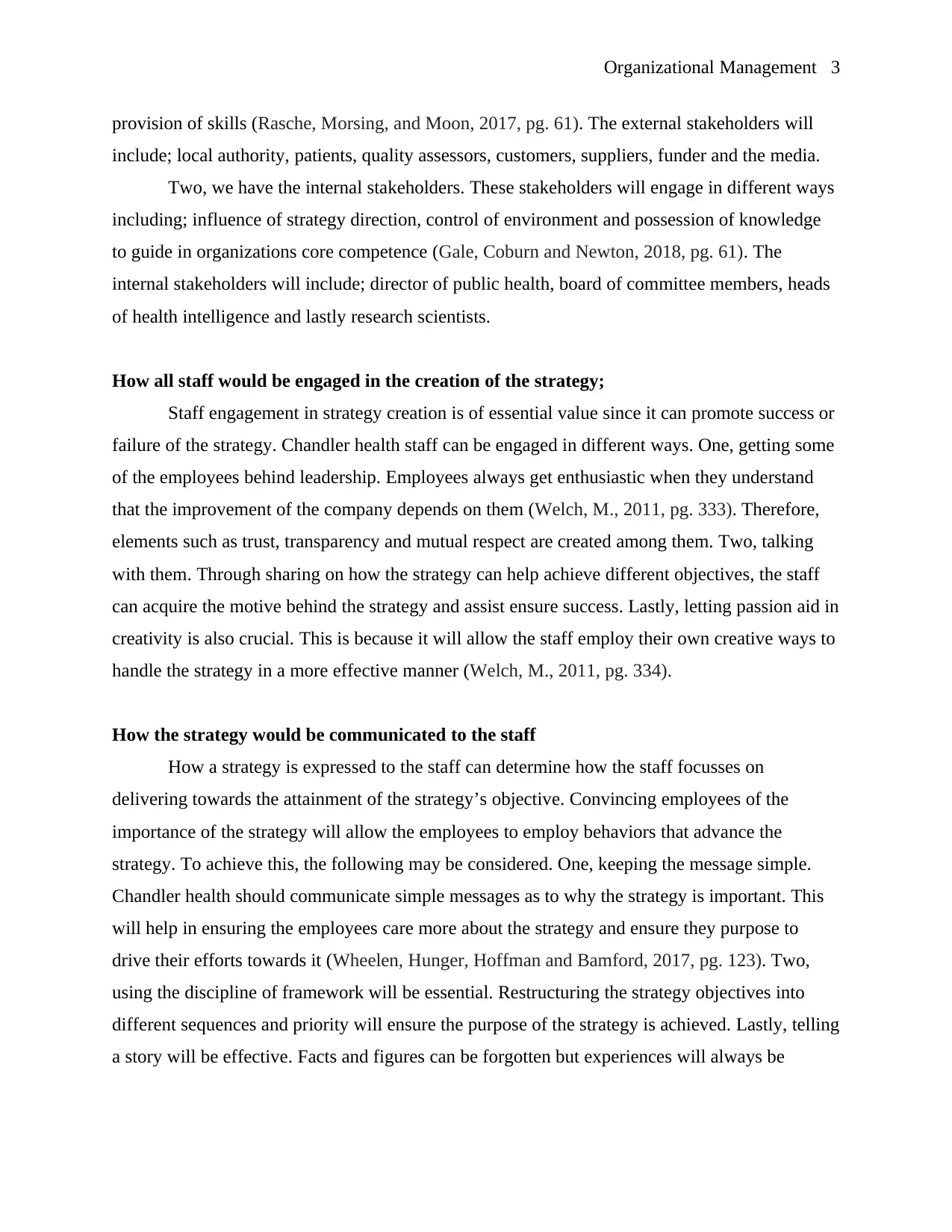
Organizational Management 3
provision of skills (Rasche, Morsing, and Moon, 2017, pg. 61). The external stakeholders will
include; local authority, patients, quality assessors, customers, suppliers, funder and the media.
Two, we have the internal stakeholders. These stakeholders will engage in different ways
including; influence of strategy direction, control of environment and possession of knowledge
to guide in organizations core competence (Gale, Coburn and Newton, 2018, pg. 61). The
internal stakeholders will include; director of public health, board of committee members, heads
of health intelligence and lastly research scientists.
How all staff would be engaged in the creation of the strategy;
Staff engagement in strategy creation is of essential value since it can promote success or
failure of the strategy. Chandler health staff can be engaged in different ways. One, getting some
of the employees behind leadership. Employees always get enthusiastic when they understand
that the improvement of the company depends on them (Welch, M., 2011, pg. 333). Therefore,
elements such as trust, transparency and mutual respect are created among them. Two, talking
with them. Through sharing on how the strategy can help achieve different objectives, the staff
can acquire the motive behind the strategy and assist ensure success. Lastly, letting passion aid in
creativity is also crucial. This is because it will allow the staff employ their own creative ways to
handle the strategy in a more effective manner (Welch, M., 2011, pg. 334).
How the strategy would be communicated to the staff
How a strategy is expressed to the staff can determine how the staff focusses on
delivering towards the attainment of the strategy’s objective. Convincing employees of the
importance of the strategy will allow the employees to employ behaviors that advance the
strategy. To achieve this, the following may be considered. One, keeping the message simple.
Chandler health should communicate simple messages as to why the strategy is important. This
will help in ensuring the employees care more about the strategy and ensure they purpose to
drive their efforts towards it (Wheelen, Hunger, Hoffman and Bamford, 2017, pg. 123). Two,
using the discipline of framework will be essential. Restructuring the strategy objectives into
different sequences and priority will ensure the purpose of the strategy is achieved. Lastly, telling
a story will be effective. Facts and figures can be forgotten but experiences will always be
provision of skills (Rasche, Morsing, and Moon, 2017, pg. 61). The external stakeholders will
include; local authority, patients, quality assessors, customers, suppliers, funder and the media.
Two, we have the internal stakeholders. These stakeholders will engage in different ways
including; influence of strategy direction, control of environment and possession of knowledge
to guide in organizations core competence (Gale, Coburn and Newton, 2018, pg. 61). The
internal stakeholders will include; director of public health, board of committee members, heads
of health intelligence and lastly research scientists.
How all staff would be engaged in the creation of the strategy;
Staff engagement in strategy creation is of essential value since it can promote success or
failure of the strategy. Chandler health staff can be engaged in different ways. One, getting some
of the employees behind leadership. Employees always get enthusiastic when they understand
that the improvement of the company depends on them (Welch, M., 2011, pg. 333). Therefore,
elements such as trust, transparency and mutual respect are created among them. Two, talking
with them. Through sharing on how the strategy can help achieve different objectives, the staff
can acquire the motive behind the strategy and assist ensure success. Lastly, letting passion aid in
creativity is also crucial. This is because it will allow the staff employ their own creative ways to
handle the strategy in a more effective manner (Welch, M., 2011, pg. 334).
How the strategy would be communicated to the staff
How a strategy is expressed to the staff can determine how the staff focusses on
delivering towards the attainment of the strategy’s objective. Convincing employees of the
importance of the strategy will allow the employees to employ behaviors that advance the
strategy. To achieve this, the following may be considered. One, keeping the message simple.
Chandler health should communicate simple messages as to why the strategy is important. This
will help in ensuring the employees care more about the strategy and ensure they purpose to
drive their efforts towards it (Wheelen, Hunger, Hoffman and Bamford, 2017, pg. 123). Two,
using the discipline of framework will be essential. Restructuring the strategy objectives into
different sequences and priority will ensure the purpose of the strategy is achieved. Lastly, telling
a story will be effective. Facts and figures can be forgotten but experiences will always be
⊘ This is a preview!⊘
Do you want full access?
Subscribe today to unlock all pages.

Trusted by 1+ million students worldwide
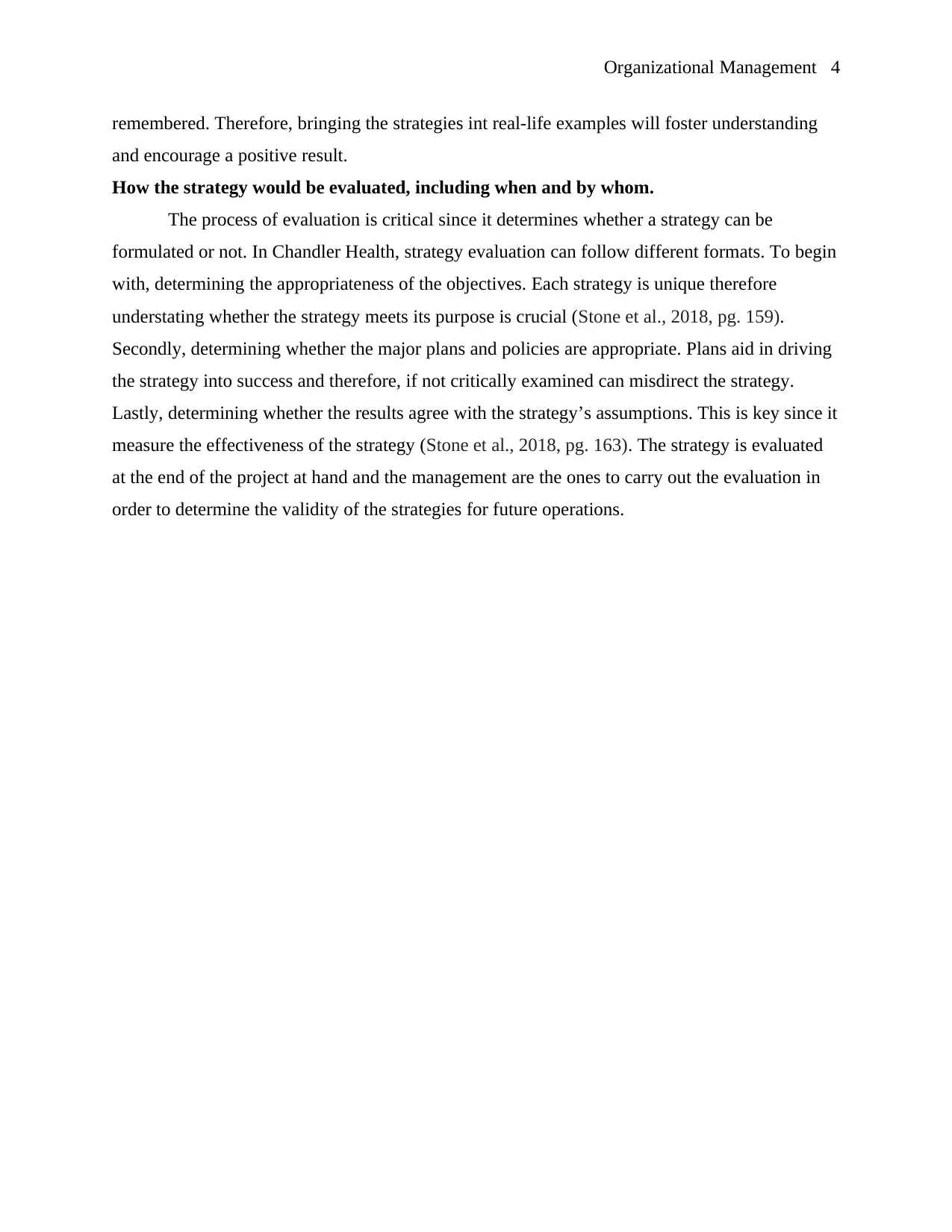
Organizational Management 4
remembered. Therefore, bringing the strategies int real-life examples will foster understanding
and encourage a positive result.
How the strategy would be evaluated, including when and by whom.
The process of evaluation is critical since it determines whether a strategy can be
formulated or not. In Chandler Health, strategy evaluation can follow different formats. To begin
with, determining the appropriateness of the objectives. Each strategy is unique therefore
understating whether the strategy meets its purpose is crucial (Stone et al., 2018, pg. 159).
Secondly, determining whether the major plans and policies are appropriate. Plans aid in driving
the strategy into success and therefore, if not critically examined can misdirect the strategy.
Lastly, determining whether the results agree with the strategy’s assumptions. This is key since it
measure the effectiveness of the strategy (Stone et al., 2018, pg. 163). The strategy is evaluated
at the end of the project at hand and the management are the ones to carry out the evaluation in
order to determine the validity of the strategies for future operations.
remembered. Therefore, bringing the strategies int real-life examples will foster understanding
and encourage a positive result.
How the strategy would be evaluated, including when and by whom.
The process of evaluation is critical since it determines whether a strategy can be
formulated or not. In Chandler Health, strategy evaluation can follow different formats. To begin
with, determining the appropriateness of the objectives. Each strategy is unique therefore
understating whether the strategy meets its purpose is crucial (Stone et al., 2018, pg. 159).
Secondly, determining whether the major plans and policies are appropriate. Plans aid in driving
the strategy into success and therefore, if not critically examined can misdirect the strategy.
Lastly, determining whether the results agree with the strategy’s assumptions. This is key since it
measure the effectiveness of the strategy (Stone et al., 2018, pg. 163). The strategy is evaluated
at the end of the project at hand and the management are the ones to carry out the evaluation in
order to determine the validity of the strategies for future operations.
Paraphrase This Document
Need a fresh take? Get an instant paraphrase of this document with our AI Paraphraser
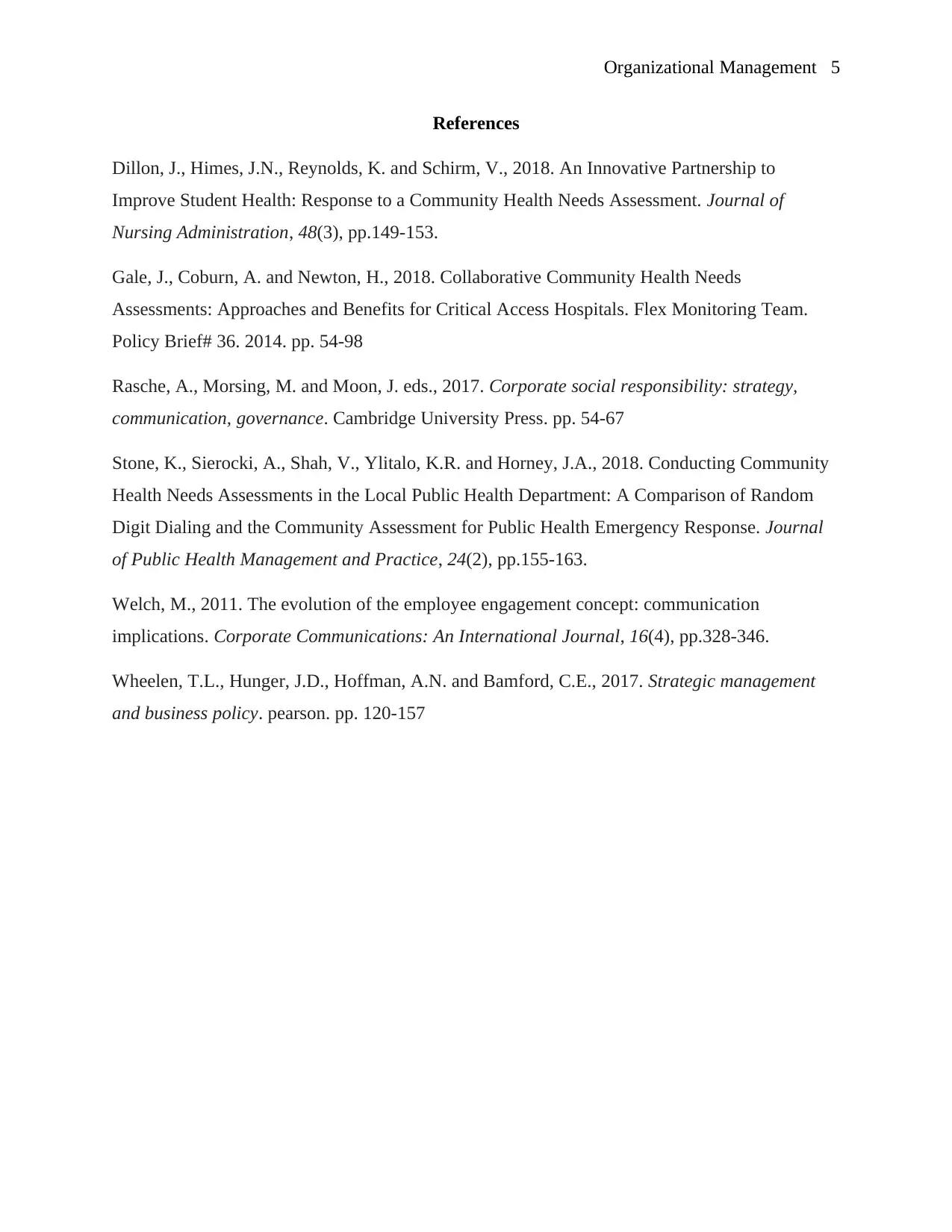
Organizational Management 5
References
Dillon, J., Himes, J.N., Reynolds, K. and Schirm, V., 2018. An Innovative Partnership to
Improve Student Health: Response to a Community Health Needs Assessment. Journal of
Nursing Administration, 48(3), pp.149-153.
Gale, J., Coburn, A. and Newton, H., 2018. Collaborative Community Health Needs
Assessments: Approaches and Benefits for Critical Access Hospitals. Flex Monitoring Team.
Policy Brief# 36. 2014. pp. 54-98
Rasche, A., Morsing, M. and Moon, J. eds., 2017. Corporate social responsibility: strategy,
communication, governance. Cambridge University Press. pp. 54-67
Stone, K., Sierocki, A., Shah, V., Ylitalo, K.R. and Horney, J.A., 2018. Conducting Community
Health Needs Assessments in the Local Public Health Department: A Comparison of Random
Digit Dialing and the Community Assessment for Public Health Emergency Response. Journal
of Public Health Management and Practice, 24(2), pp.155-163.
Welch, M., 2011. The evolution of the employee engagement concept: communication
implications. Corporate Communications: An International Journal, 16(4), pp.328-346.
Wheelen, T.L., Hunger, J.D., Hoffman, A.N. and Bamford, C.E., 2017. Strategic management
and business policy. pearson. pp. 120-157
References
Dillon, J., Himes, J.N., Reynolds, K. and Schirm, V., 2018. An Innovative Partnership to
Improve Student Health: Response to a Community Health Needs Assessment. Journal of
Nursing Administration, 48(3), pp.149-153.
Gale, J., Coburn, A. and Newton, H., 2018. Collaborative Community Health Needs
Assessments: Approaches and Benefits for Critical Access Hospitals. Flex Monitoring Team.
Policy Brief# 36. 2014. pp. 54-98
Rasche, A., Morsing, M. and Moon, J. eds., 2017. Corporate social responsibility: strategy,
communication, governance. Cambridge University Press. pp. 54-67
Stone, K., Sierocki, A., Shah, V., Ylitalo, K.R. and Horney, J.A., 2018. Conducting Community
Health Needs Assessments in the Local Public Health Department: A Comparison of Random
Digit Dialing and the Community Assessment for Public Health Emergency Response. Journal
of Public Health Management and Practice, 24(2), pp.155-163.
Welch, M., 2011. The evolution of the employee engagement concept: communication
implications. Corporate Communications: An International Journal, 16(4), pp.328-346.
Wheelen, T.L., Hunger, J.D., Hoffman, A.N. and Bamford, C.E., 2017. Strategic management
and business policy. pearson. pp. 120-157
1 out of 5
Related Documents
Your All-in-One AI-Powered Toolkit for Academic Success.
+13062052269
info@desklib.com
Available 24*7 on WhatsApp / Email
![[object Object]](/_next/static/media/star-bottom.7253800d.svg)
Unlock your academic potential
Copyright © 2020–2025 A2Z Services. All Rights Reserved. Developed and managed by ZUCOL.





